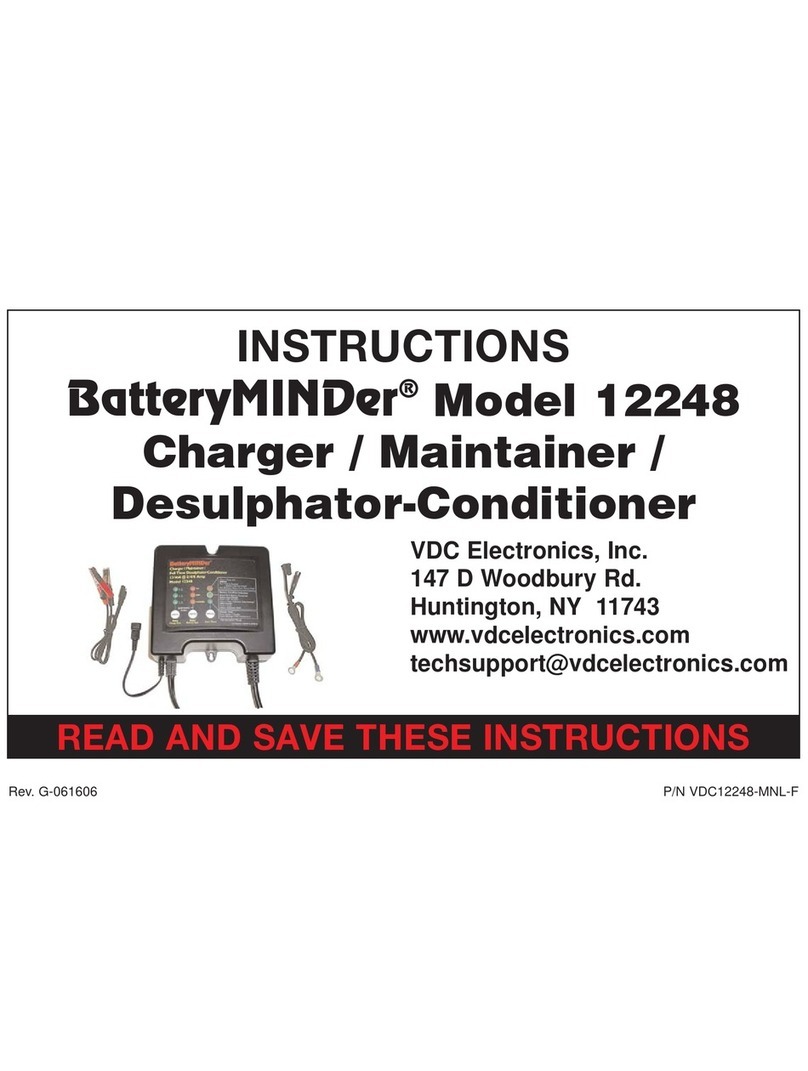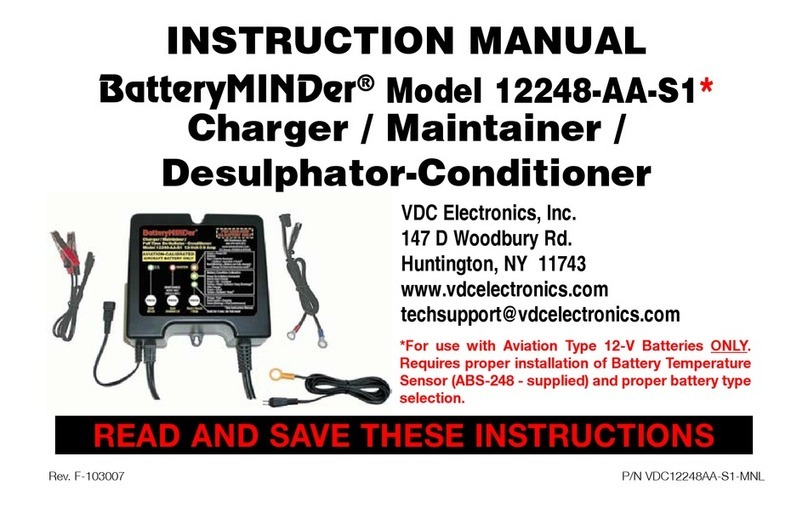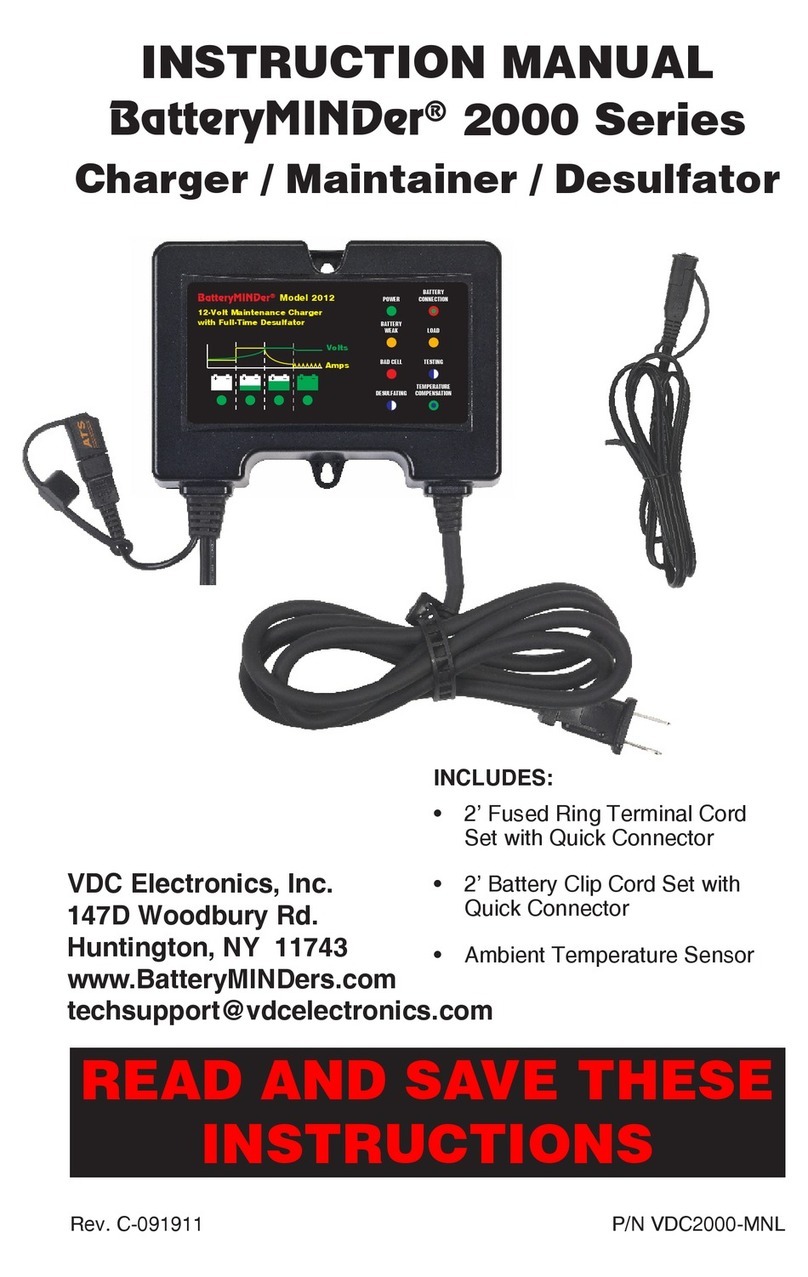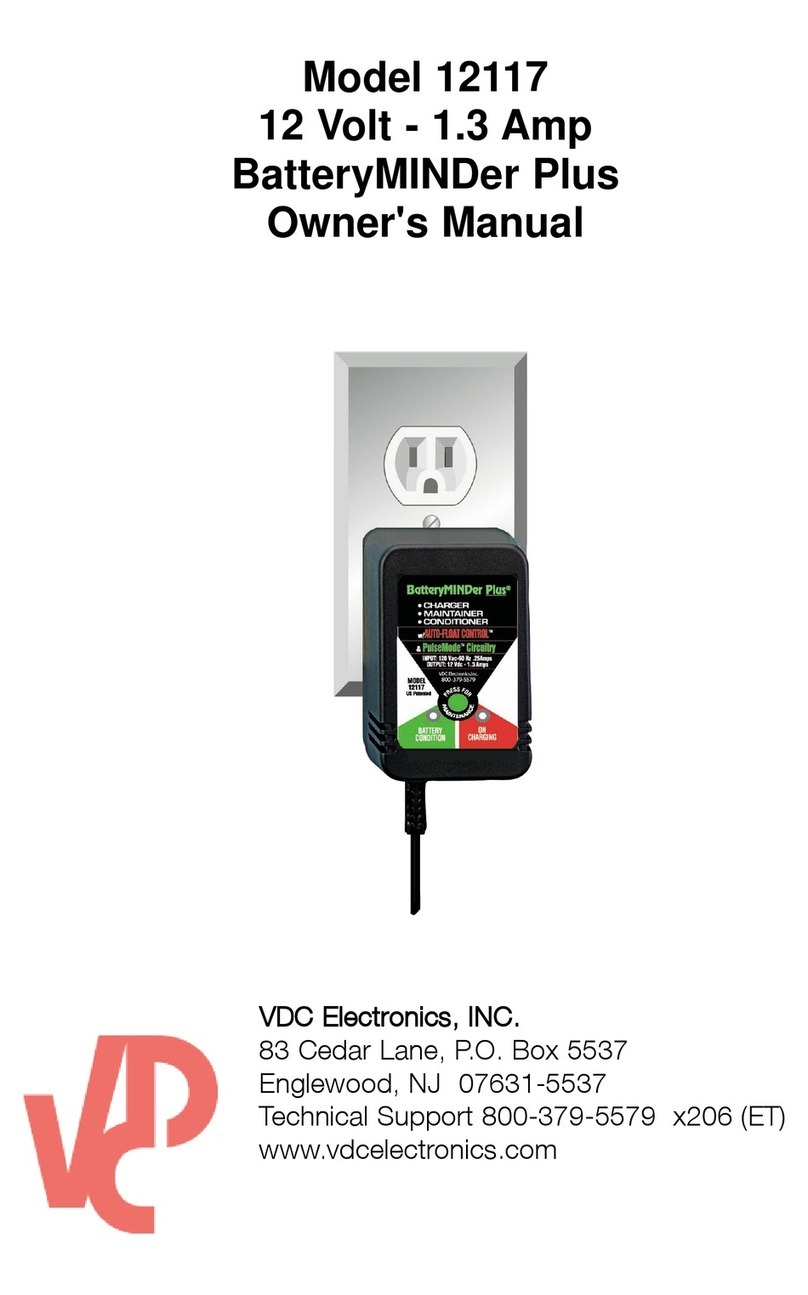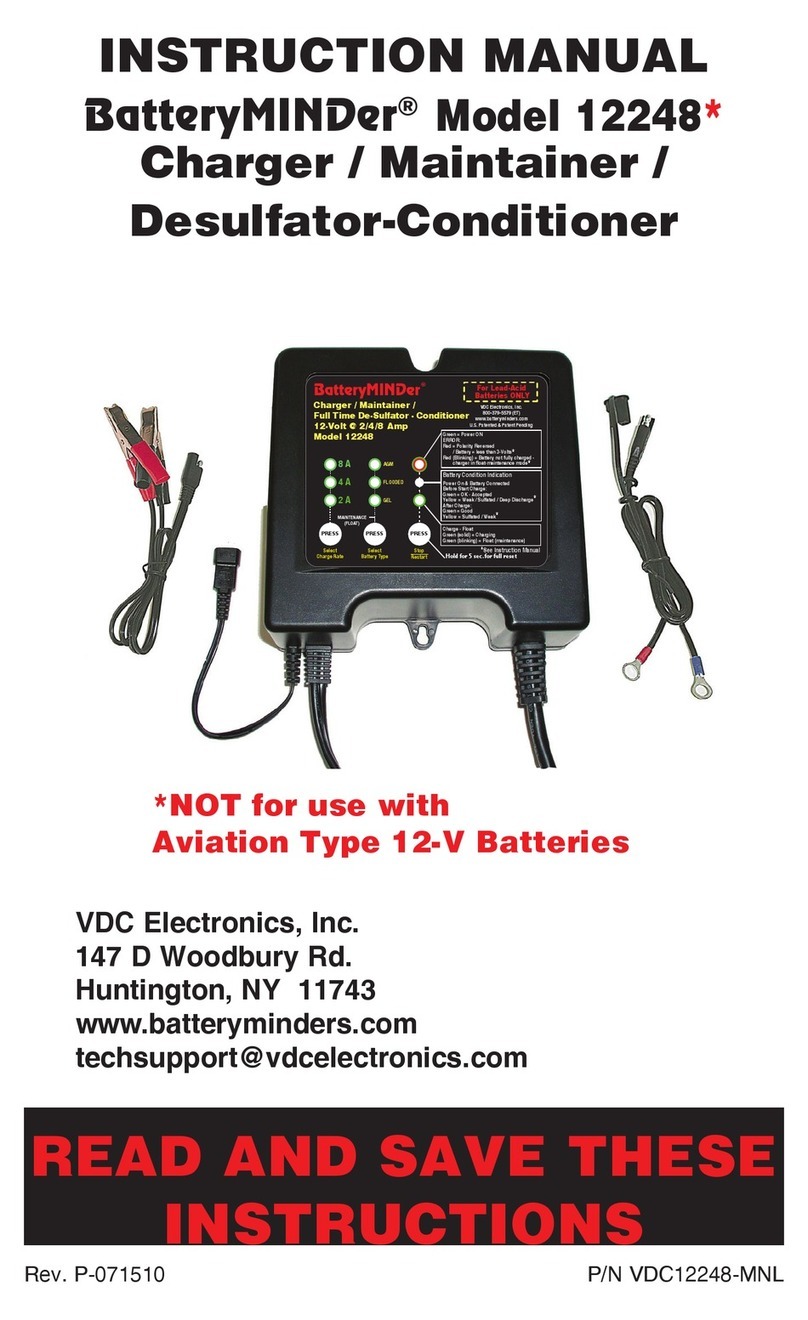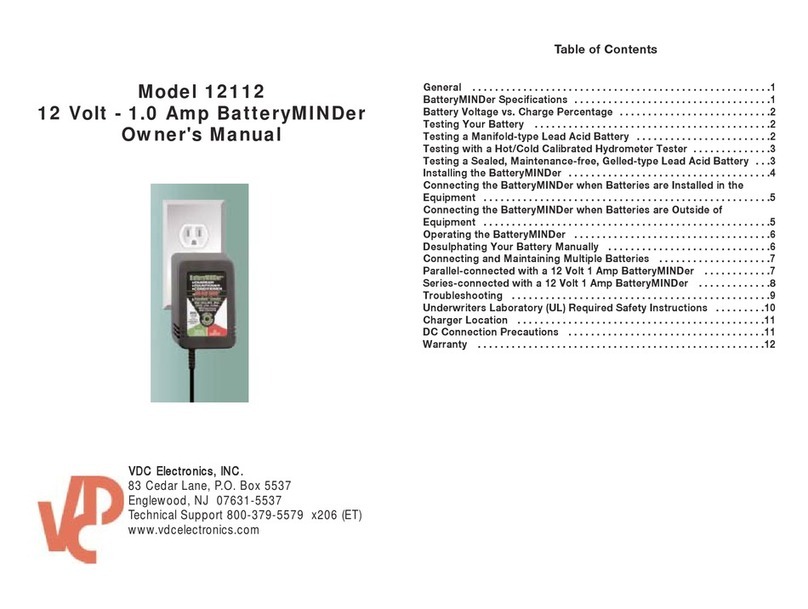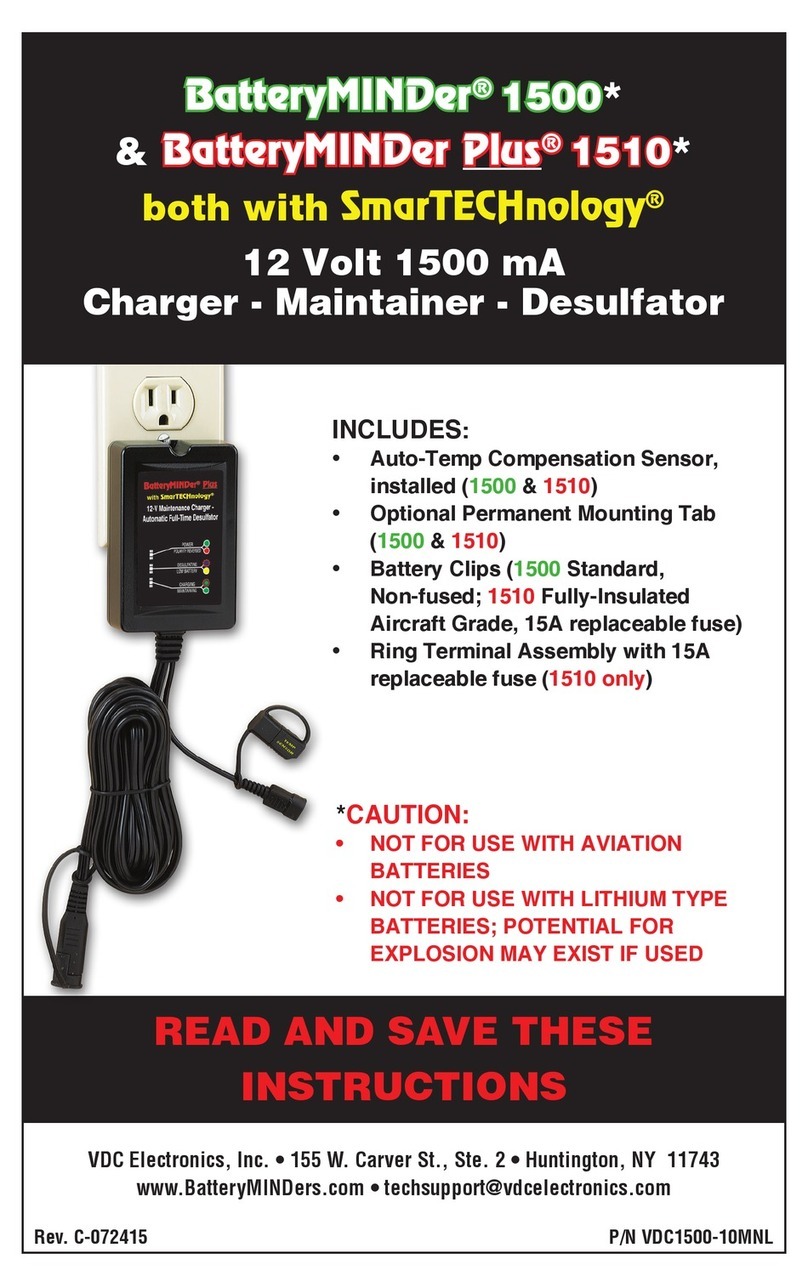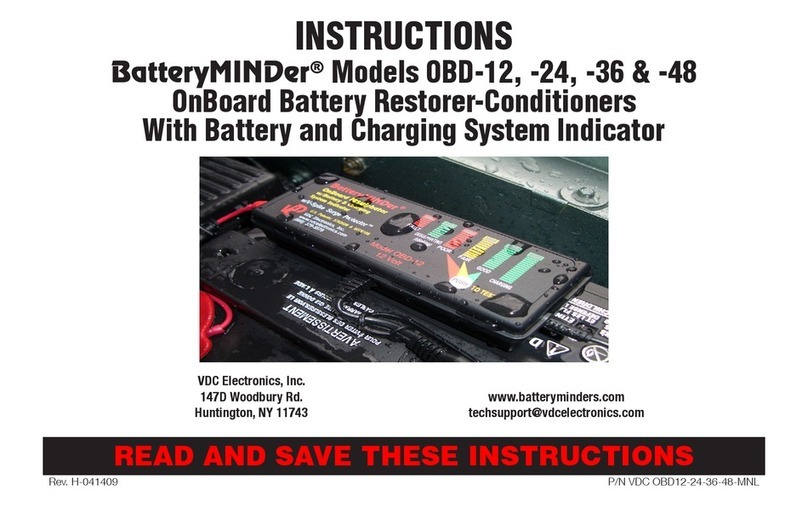
3
specific gravity or filling.
d. Do not operate charger in a closed-in area or restrict ventilation
in any way.
e. Do not set battery on top of charger.
DC CONNECTION PRECAUTIONS
a. Connect and disconnect DC output clips only after removing
charger from outlet.
b. Never allow clips to touch each other.
c. Attach clips to battery posts and twist or rock back and forth
several times to make good contact.This tends to keep clips
from slipping off terminals and reduces risk of sparking.
FOLLOW THESE INSTRUCTIONS WHEN BATTERY IS
INSTALLED IN EQUIPMENT (VEHICLE, PWC, BOAT,TRACTOR,
ETC.) A SPARK NEAR BATTERY MAY CAUSE BATTERY TO
EXPLODE.TO REDUCE RISK OF A SPARK NEAR BATTERY:
d. Position DC output cord to reduce risk of damage by hood, door,
covers, or moving engine parts.
e. Stay clear of fan blades, belts, pulleys, and other parts that can
cause injuries.
f. Check polarity of battery posts.POSITIVE (POS, P, +) usually has
a larger diameter than NEGATIVE (NEG, N, -)POST.
g. Determine which post of battery is grounded (connected) to the
chassis of equipment. If negative post is grounded see Item N. If
positive post is grounded see item P. N. For negative grounded
equipment, connect POSITIVE (RED) clip from charger to
POSITIVE (POS, P, +) ungrounded post of battery. Connect
NEGATIVE (BLACK) clip to vehicle chassis or engine block away
from battery. Do not connect clip to carburetor, fuel lines, or
metal body parts. P. For positive ground equipment, connect
NEGATIVE (BLACK) clip from charger to NEGATIVE (NEG, N, -)
UNGROUNDED POST OF BATTERY. Connect POSITIVE (RED)
CLIP to chassis or engine block away from battery. Do not
connect clip to carburetor, fuel lines, or sheet metal body parts.
Connect to heavy gauge metal part of frame or engine.
h. When disconnecting charger, disconnect charger from AC outlet,
then remove clips from vehicle chassis, and battery posts.
Operating instructions for charge information.
FOLLOW THESE STEPS WHEN BATTERY IS OUTSIDE OF
VEHICLE OR EQUIPMENT.
A SPARK NEAR THE BATTERY MAY CAUSE BATTERY
EXPLOSION.TO REDUCE RISK OF A SPARK NEAR BATTERY:
a. Check polarity of battery posts.POSITIVE (POS,P,+) usually has
a large diameter than NEGATIVE (NEG, N, -) battery post.
b. Attach at least a 24 inch long 6 gauge (AG) insulated battery
cable to NEGATIVE (NEG -), BATTERY POST.
c. Connect (RED) charger clip to (POS+) post of battery
d. Position yourself and free end of cable as far away from battery
as possible,then connect NEGATIVE (BLACK) charger clip to free
end of cable.
e. Do not face battery when making final connections
f. When disconnecting charger, always do so in reverse sequence
of connecting procedure and break first connection while as far
away from battery as is practical.
g. A marine (boat) battery must be removed and charged on shore.
To charge it on board requires equipment specifically designed
for marine use.
MAINTENANCE INSTRUCTIONS
DO NOT ATTEMPT TO REPAIR. UNIT IS NOT DESIGNED TO BE
REPAIRED. ALL SERVICING SHOULD BE PERFORMED BY
VDC Electronics, Inc. PERSONNEL.
GENERAL INFORMATION
It is possible to re-charge a “dead” or shorted cell battery using a
high current i.e.5 Amp + charger which “forces”the battery to accept
a “temporary false charge”. Don’t be fooled by a voltmeter or quick
load test. Only when a battery has been put back into service and a
real life load has been put on it, will it become apparent that the bat-
tery is not “healthy” and fully re-charged. It will collapse under the
load and perform much like a battery that was not fully charged in
the first place. Buy a good quality replacement battery and take
proper care by keeping your
BatteryMINDer
connected to your bat-
tery at all times - (this means all year round) it is not in use for 4
days or more. Remember your
BatteryMINDer
uses less than a
dime’s worth of electricity per month running 24 hrs. per day and it
is warranted for five (5) years.
OPERATING INSTRUCTIONS:
DO NOT ATTEMPTTO OPERATE CHARGER BEFORE READING
AND FULLY UNDERSTANDING ALL SAFETY INSTRUCTIONS
AS OUTLINED PRIOR. CALL OUR TOLL FREE TELEPHONE
NUMBER IFYOU HAVE ANY QUESTIONS WHATSOEVER.
1.
BatteryMINDer
is designed to fully charge your battery(s),
but should be left connected to the battery at all times the bat-
tery is not in use. Failure to maintain the battery in a full charge
condition at all times will cause the battery to sulphate, seri-
ously limiting it’s life and performance. In addition, this
ensures you will always have a fully charged battery. The
amount of electricity it uses when the battery is fully charged
is less than 10¢ month even when electricity costs as much as
14¢ /kWh. Compare this cost to needing to replace a battery
after only one season of use due to sulphation caused by
improper charging and/or storage.
2. After carefully reading and fully understanding the safety
instructions, provided in these instructions, each time you
wish to store your battery or whenever you will not be using it
for a 4 days or more, simply attach
BatteryMINDer
as described
in the safety instructions and let it do its job.
NOTE: It is normal for
BatteryMINDer
to feel warm to the touch
during the charging cycle, especially with older and/or large
batteries. Unit will begin to
cool, when it nears the end of the charging mode and during
the entire float maintenance + de-sulphation mode.
The Green LED de-sulphation + maintenance indicator will light
when you have properly attached unit’s clips to the battery
posts ie: Red marked clip to (+) post and Black marked clip (–)
post of battery. LED will begin to blink when battery has been
fully charged and is now in the Auto-Float Maintenance + de-
sulphation mode. The Red LED will come on when the unit is
plugged into live 120 volt AC electrical outlet. It will remain on
throughout the entire charging mode as well as during the float
maintenance mode.SHOULD THE Red indicator NOT REMAIN
ON, CHECKTO BE SURE UNIT IS PLUGGED IN AND OUTLET IS
STILL LIVE. If outlet is live and Red LED does not light, unit is
NOT PROPERLY CHARGING or MAINTAINING battery correctly.
Disconnect unit and return immediately to VDC Electronics for
inspection / repair or replacement.
NOTE:The Green LED indicator will light even when unit is not
connected to a live outlet, as it is activated by the battery’s own
voltage. Do not leave
BatteryMINDer
connected to the battery
without electrical power. The battery energy used to light the
LED will cause the battery to discharge over time.
IMPORTANT: It is recommended to charge large capacity
deeply discharged batteries with your standard charger before
attaching
BatteryMINDer
to minimize the time it will take for
BatteryMINDer
to enter the Desulphation Maintenance mode. If
the Green LED does not start blinking within 72 hours after unit
has been attached to a fully charged battery the BATTERY MAY
HAVE A SHORTED CELL OR IS TOO HIGHLY SULPHATED TO
ACCEPT A PROPER CHARGE.
DE-SULPHATION BUTTON
If
BatteryMINDer
is unable to bring the battery up to a full charge
voltage, it will not “blink” and will remain in the charge mode (solid
